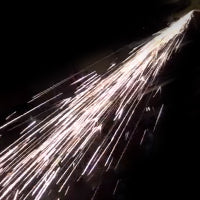Welders didn’t invent the overhead position. The artist, Michelangelo, was one of the first. He spent 4 years on the Sistine Chapel ceiling, paint dripping into his eyes the entire time. For all the fame and fortune it brought him, Michelangelo was never able to see very well again. What Mikey needed was some solid advice. Too bad he's dead. So, here's some overhead welding tips only for you.
Safety First
People never say safety first when it really matters. Did you ever hear “Safety First” during the entire movie, JAWS? If you’re not thinking safety first with overhead welds, you’re risking a similar fate (meaning incredible pain, not being eaten by a giant shark). During an overhead weld, gravity is going to pull all that burning slag and other material down onto you.
First, It’s important to have a good helmet that covers most of your head, or to have flame-resistant hair gel. Miller just came out with an incredible new line of Helmets that you can learn more about here.
Second, you’ll want good protection for your arms. Having just a jacket isn’t good enough. It needs to be thick enough to withstand the fiery blizzard of molten slag you’re about to endure. It’s also helpful if it’s flame-resistant. Trust us, having the right jacket isn’t a try-and-try again thing. Here’s some of our favorites:
LINCOLN BLACK FLAME RETARDANT LAB COAT
So what happens when you don’t follow these safety tips? The video below is a great example.
Account For The Heat
Heat rises. Most welders normally work with their project below their welding gun, meaning the heat harmlessly moves up into empty space. However, when your workpiece is above your welding gun, the heat rises up into your weld. This can cause your weld to penetrate further into the piece or cause more warpage than you’re used to. An easy solution is slightly turning your amps down from your regular settings.
Avoid Getting Tired
Welding over your head takes more energy than normal. As your arms become tired and begin to shake, your welds will suffer. A smart trick is to wrap your lead around your wrist. This way, your entire arm can help hold the weight of your welding equipment.
Come Closer
You’re six feet tall. With Your wingspan, that gives you 8 feet. Plus another 6 inches from the welding gun. That means you can weld something 8 ft. 6 inches over your head without a ladder, right? Sure, if you’re okay with an 8 ft. 6 inch coffin. Welding on your tippy toes is a terrible idea. Expert welders know it’s best to get as close to your workpiece as possible so that you can feel comfortable. That might mean using ladders and extension cords, but the extra effort will definitely be worth it.
These tips should help you perfect your overhead weld while avoiding a hair full of fire. What have you found works best for your overhead welds? Share the knowledge in the comments section down below.




